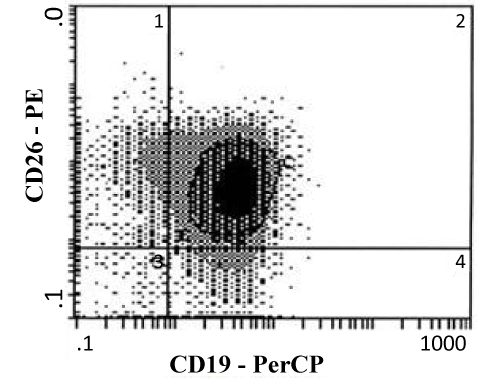CD49D AND CD26 ARE INDEPENDENT PROGNOSTIC MARKERS FOR DISEASEPROGRESSION IN PATIENTS WITH CHRONIC LYMPHOCYTIC LEUKEMIA
(Abstract release date: 05/19/16)
EHA Library. Ibrahem l. 06/09/16; 134685; PB1785

Dr. lamia Ibrahem
Contributions
Contributions
Abstract
Abstract: PB1785
Type: Publication Only
Background
CLL is characterized by extremely variable clinical course. Several prognostic factors can predict disease progression and therapeutic outcomes in those patients.
Aims
The aim was to evaluate the use of CD49d and CD26 as independent prognostic markers in CLL patients. The present study measured surface expression of CD49d and CD26 by three-color flow cytometry in a series of 103 untreated CLL patients.
Methods
The present study measured surface expression of CD49d and CD26 by three-color flow cytometry in a series of 103 untreated CLL patients. We evaluated the prognostic role of CD49d and CD26 to predict the risk of lymphocyte doubling, disease progression and overall survival.
Results
We evaluated the prognostic role of CD49dand CD26 to predict the risk of lymphocyte doubling, disease progression and overall survival.We confirmed thatCD49d and CD26 were significant predictors of lymphocyte doubling(P b 0.001 for both markers) and diseaseprogression (P b 0.001 for both markers) but insignificant for overall survival(P=0.303 and 0.519 respectively. Multivariate analysis between clinical parameters and flow cytometry markers revealed that CD49d and CD26are independent prognostic markers for lymphocyte doubling (HR = 1.487 P = 007 and HR = 2.248, P =0.014 respectively) and progression to a more advanced stage (HR = 3.191, P = 0.049 and HR = 7.887, P =0.003)
Conclusion
Also, concordant expression of both markers was found to improve their predictive power.Many studiesreported that CD49d and CD26 combined analysis was found to improve their power to predict the risk of lymphocytedoubling and disease progression. CD49d and CD26 have independent prognostic value and we suggestits use as a part of routine panel for prognostic stratification of CLL.

Session topic: E-poster
Keyword(s): Chronic lymphocytic leukemia, Flow cytometry, Prognostic factor
Type: Publication Only
Background
CLL is characterized by extremely variable clinical course. Several prognostic factors can predict disease progression and therapeutic outcomes in those patients.
Aims
The aim was to evaluate the use of CD49d and CD26 as independent prognostic markers in CLL patients. The present study measured surface expression of CD49d and CD26 by three-color flow cytometry in a series of 103 untreated CLL patients.
Methods
The present study measured surface expression of CD49d and CD26 by three-color flow cytometry in a series of 103 untreated CLL patients. We evaluated the prognostic role of CD49d and CD26 to predict the risk of lymphocyte doubling, disease progression and overall survival.
Results
We evaluated the prognostic role of CD49dand CD26 to predict the risk of lymphocyte doubling, disease progression and overall survival.We confirmed thatCD49d and CD26 were significant predictors of lymphocyte doubling(P b 0.001 for both markers) and diseaseprogression (P b 0.001 for both markers) but insignificant for overall survival(P=0.303 and 0.519 respectively. Multivariate analysis between clinical parameters and flow cytometry markers revealed that CD49d and CD26are independent prognostic markers for lymphocyte doubling (HR = 1.487 P = 007 and HR = 2.248, P =0.014 respectively) and progression to a more advanced stage (HR = 3.191, P = 0.049 and HR = 7.887, P =0.003)
Conclusion
Also, concordant expression of both markers was found to improve their predictive power.Many studiesreported that CD49d and CD26 combined analysis was found to improve their power to predict the risk of lymphocytedoubling and disease progression. CD49d and CD26 have independent prognostic value and we suggestits use as a part of routine panel for prognostic stratification of CLL.

Session topic: E-poster
Keyword(s): Chronic lymphocytic leukemia, Flow cytometry, Prognostic factor
Abstract: PB1785
Type: Publication Only
Background
CLL is characterized by extremely variable clinical course. Several prognostic factors can predict disease progression and therapeutic outcomes in those patients.
Aims
The aim was to evaluate the use of CD49d and CD26 as independent prognostic markers in CLL patients. The present study measured surface expression of CD49d and CD26 by three-color flow cytometry in a series of 103 untreated CLL patients.
Methods
The present study measured surface expression of CD49d and CD26 by three-color flow cytometry in a series of 103 untreated CLL patients. We evaluated the prognostic role of CD49d and CD26 to predict the risk of lymphocyte doubling, disease progression and overall survival.
Results
We evaluated the prognostic role of CD49dand CD26 to predict the risk of lymphocyte doubling, disease progression and overall survival.We confirmed thatCD49d and CD26 were significant predictors of lymphocyte doubling(P b 0.001 for both markers) and diseaseprogression (P b 0.001 for both markers) but insignificant for overall survival(P=0.303 and 0.519 respectively. Multivariate analysis between clinical parameters and flow cytometry markers revealed that CD49d and CD26are independent prognostic markers for lymphocyte doubling (HR = 1.487 P = 007 and HR = 2.248, P =0.014 respectively) and progression to a more advanced stage (HR = 3.191, P = 0.049 and HR = 7.887, P =0.003)
Conclusion
Also, concordant expression of both markers was found to improve their predictive power.Many studiesreported that CD49d and CD26 combined analysis was found to improve their power to predict the risk of lymphocytedoubling and disease progression. CD49d and CD26 have independent prognostic value and we suggestits use as a part of routine panel for prognostic stratification of CLL.

Session topic: E-poster
Keyword(s): Chronic lymphocytic leukemia, Flow cytometry, Prognostic factor
Type: Publication Only
Background
CLL is characterized by extremely variable clinical course. Several prognostic factors can predict disease progression and therapeutic outcomes in those patients.
Aims
The aim was to evaluate the use of CD49d and CD26 as independent prognostic markers in CLL patients. The present study measured surface expression of CD49d and CD26 by three-color flow cytometry in a series of 103 untreated CLL patients.
Methods
The present study measured surface expression of CD49d and CD26 by three-color flow cytometry in a series of 103 untreated CLL patients. We evaluated the prognostic role of CD49d and CD26 to predict the risk of lymphocyte doubling, disease progression and overall survival.
Results
We evaluated the prognostic role of CD49dand CD26 to predict the risk of lymphocyte doubling, disease progression and overall survival.We confirmed thatCD49d and CD26 were significant predictors of lymphocyte doubling(P b 0.001 for both markers) and diseaseprogression (P b 0.001 for both markers) but insignificant for overall survival(P=0.303 and 0.519 respectively. Multivariate analysis between clinical parameters and flow cytometry markers revealed that CD49d and CD26are independent prognostic markers for lymphocyte doubling (HR = 1.487 P = 007 and HR = 2.248, P =0.014 respectively) and progression to a more advanced stage (HR = 3.191, P = 0.049 and HR = 7.887, P =0.003)
Conclusion
Also, concordant expression of both markers was found to improve their predictive power.Many studiesreported that CD49d and CD26 combined analysis was found to improve their power to predict the risk of lymphocytedoubling and disease progression. CD49d and CD26 have independent prognostic value and we suggestits use as a part of routine panel for prognostic stratification of CLL.

Session topic: E-poster
Keyword(s): Chronic lymphocytic leukemia, Flow cytometry, Prognostic factor
{{ help_message }}
{{filter}}


